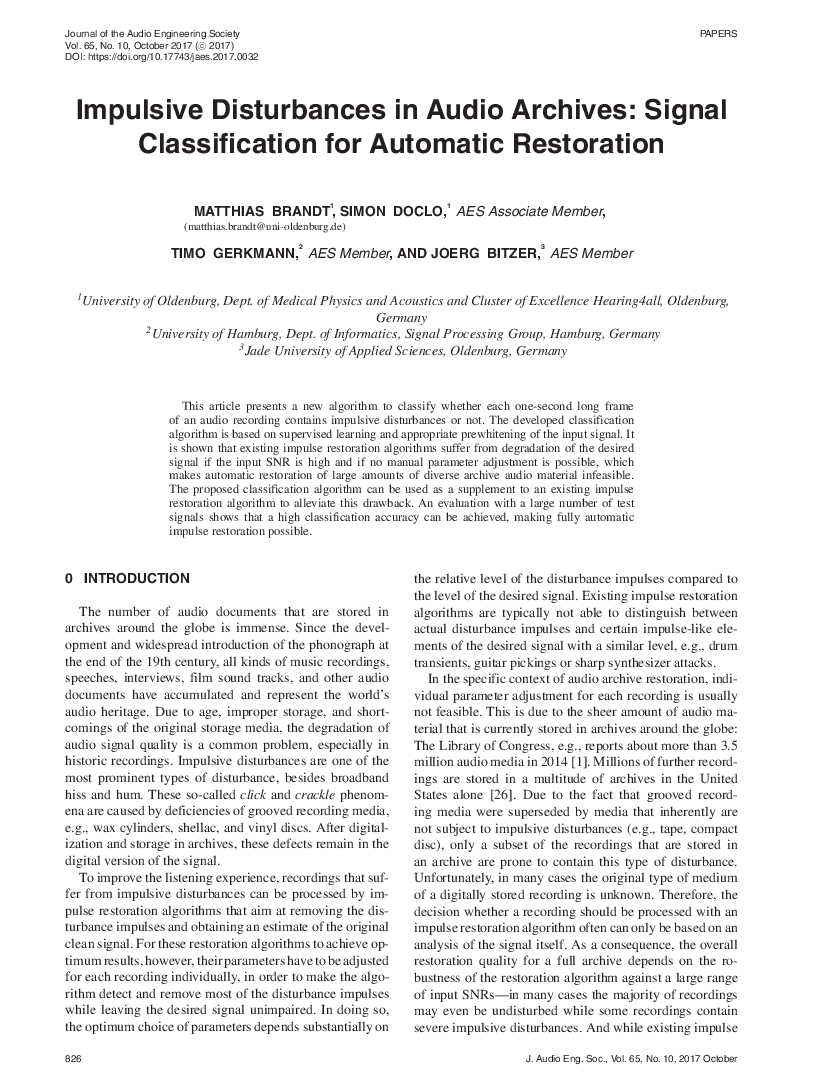Home / Publications / E-library page
You are currently logged in as an
Institutional Subscriber.
If you would like to logout,
please click on the button below.
Home / Publications / E-library page
Only AES members and Institutional Journal Subscribers can download
Historic recordings usually have degraded audio quality because of their age, improper storage, and the shortcomings of the original media. One typical problem is the presence of impulsive disturbances. Recordings that suffer from clicks and crackles can be processed by impulse-restoration algorithms to improve their audio quality. This report presents a new algorithm that classifies one-second frames of an audio recording based on the existence of impulsive disturbances. The algorithm uses supervised learning. It is shown that existing impulse-restoration algorithms suffer from degradation of the desired signal if the input SNR is high and if no manual parameter adjustment is possible. This would make automatic restoration of large amounts of diverse archive audio material unfeasible. The proposed classification algorithm can be used as a supplement to an existing impulse-restoration algorithm to alleviate this drawback. An evaluation using a large number of test signals shows that high classification accuracy can be achieved, making automatic impulse restoration possible. Results show that prewhitening of the input signal by means of a phase-only transform serves to increase the detectability of disturbance impulses, which can also be used as a detection enhancement method for impulse-restoration algorithms.
Author (s): Brandt, Matthias; Doclo, Simon; Gerkmann, Timo; Bitzer, Joerg
Affiliation:
University of Oldenburg, Dept. of Medical Physics and Acoustics and Cluster of Excellence Hearing4all, Oldenburg, Germany; University of Hamburg, Dept. of Informatics, Signal Processing Group, Hamburg, Germany; Jade University of Applied Sciences, Oldenburg, Germany
(See document for exact affiliation information.)
Publication Date:
2017-10-06
Import into BibTeX
Permalink: https://aes2.org/publications/elibrary-page/?id=19356
(426KB)
Click to purchase paper as a non-member or login as an AES member. If your company or school subscribes to the E-Library then switch to the institutional version. If you are not an AES member Join the AES. If you need to check your member status, login to the Member Portal.

Brandt, Matthias; Doclo, Simon; Gerkmann, Timo; Bitzer, Joerg; 2017; Impulsive Disturbances in Audio Archives: Signal Classification for Automatic Restoration [PDF]; University of Oldenburg, Dept. of Medical Physics and Acoustics and Cluster of Excellence Hearing4all, Oldenburg, Germany; University of Hamburg, Dept. of Informatics, Signal Processing Group, Hamburg, Germany; Jade University of Applied Sciences, Oldenburg, Germany; Paper ; Available from: https://aes2.org/publications/elibrary-page/?id=19356
Brandt, Matthias; Doclo, Simon; Gerkmann, Timo; Bitzer, Joerg; Impulsive Disturbances in Audio Archives: Signal Classification for Automatic Restoration [PDF]; University of Oldenburg, Dept. of Medical Physics and Acoustics and Cluster of Excellence Hearing4all, Oldenburg, Germany; University of Hamburg, Dept. of Informatics, Signal Processing Group, Hamburg, Germany; Jade University of Applied Sciences, Oldenburg, Germany; Paper ; 2017 Available: https://aes2.org/publications/elibrary-page/?id=19356
@article{brandt2017impulsive,
author={brandt matthias and doclo simon and gerkmann timo and bitzer joerg},
journal={journal of the audio engineering society},
title={impulsive disturbances in audio archives: signal classification for automatic restoration},
year={2017},
volume={65},
issue={10},
pages={826-840},
month={october},}